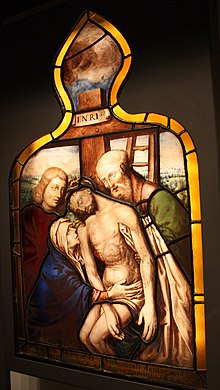Abraham van Linge (fl. 1625–41) and his eldest brother Bernard van Linge (1598 – c. 1644) were window painters from Emden, East Frisia, where their father and grandfather were glaziers.[1] They completed the bulk of their work in England between the 1620s and the 1640s. They painted at a time when stained glass was losing popularity in favour of their method, the usage of vitreous enamels on glass as a blank canvas and then fired. Lead lining is used to hold together pieces of glass. The duration and intensity of the firing determined the final colour along with the colour and type of enamel.

Bernard van Linge worked in Paris from 1617 to 1621. When religious conflicts broke out in France, he fled to London around 1621, where he quickly found employment in a glazier's studio through connections in the Dutch expatriate community. Abraham joined him around 1623.[1]
Abraham van Linge must have been born in 1604–5, as he was aged 29 when he was matriculated at the University of Oxford as a privileged person on 4 July 1634, with his profession given as "Artis Peritus" (art expert).[2] His work can be seen most prominently in the chapels of University College, Oxford, and Lincoln College, Oxford, and at Christ Church, Oxford, in England, where the lead lining is particularly noticeable.[3] His work is supposedly in the Duke Humfrey reading room of the Bodleian Library, also in Oxford, although it is not certain whether the painted glass frames are by him or simply done in his style.
References
edit- ^ a b Alexander Faludy, Linge, Bernard van, entry in the Oxford Dictionary of National Biography
- ^ Alumni Oxonienses
- ^ Encyclopædia Britannica, 'Stained Glass', 'Periods and centres of activity » 17th and 18th centuries'